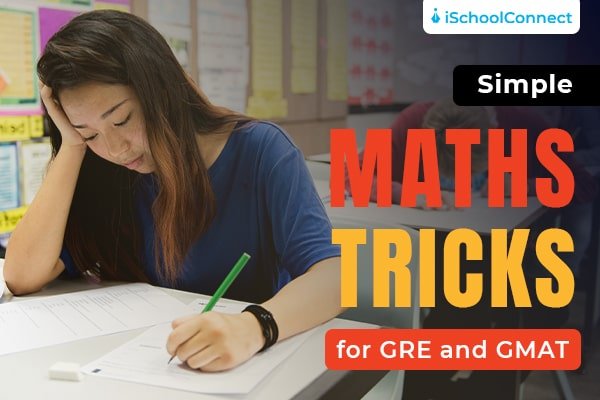Table of Contents
The Graduate Record Examinations (GRE) and the Graduate Management Admission Test (GMAT) are two of the most prestigious exams that can pave the way for admission into esteemed universities. However, these exams entail some complex mathematical problems, and you may need a few maths tricks up your sleeve to ace them.
Here are some maths tricks for competitive exams. Go, nail those exams and get into your dream university.
GMAT Math tricks
The GMAT exam has two types of mathematical questions (also known as quantitative reasoning questions). These include:
- Problem Solving questions
- Data Sufficiency questions
The former tests your ability to use problem-solving skills to find solutions to mathematical problems. On the other hand, the latter checks your ability to recognize relevant data in a given problem and deduce solutions from it.
You can use some of these maths tricks for fast calculations to solve the quantitative reasoning questions in the GMAT exams.

1. Use multiples of 10 to simplify math problems
You will probably be faced with complex mathematical problems in the Problem Solving and Data Sufficiency sections of the GMAT. To solve these questions, you can break down the calculations into multiples of 10.
In addition and subtractions, you can round off the numbers to their nearest 10s, 100s, or even 1000s. After that, you can add or subtract these numbers according to the question’s criteria. Then, you need to add or subtract the numbers you rounded off to or from the result depending upon whether it is an addition or subtraction problem.
For example: “6625 + 8641” can be added as 6000+8000+600+600+20+40+5+1
You can use such easy maths tricks when solving math problems in the GMAT. Additionally, you can use this same trick in multiplication and division problems as well.
2. Plugin numbers to solve Algebraic Expressions

While this may not be a highly recommended trick, it can be more useful than you might think. You can use this trick in algebraic problems with more than one variable to find the right value for the variable in question. Besides this, you can also use it to balance algebraic equations with multiple variables. However, be cautious while solving questions with this trick, as it might sometimes lead to misleading answers.
To use this trick, all you have to do is substitute the variables in an algebraic equation with simple numbers. As a result, it will help you rationally visualize the equation and solve it faster. Although this trick works most of the time, certain complex algebraic problems may give the wrong result when using this trick.
Let’s look at an example of when this trick can give the right result.
To practice law in their state, the third-year law students at a University have to pass the bar examination. If ⦢ of the class opted not to take the bar examination and ⦢ of those who did take the test, did so and failed. What percent of the 3Ls will be able to practice law in their state?
In such a scenario, you can plug in a simple number. Then, assume it as the total number of third-year law students, and continue with the calculation. You can easily solve these types of Data Sufficiency problems with this neat maths trick.
3. Reverse calculation in Problem Solving questions
Apart from plugging in numbers, there is another popular trick that you can use to solve the Problem Solving quantitative questions in GMAT. It goes with the name reverse calculation or back-calculation. This trick is especially useful when you have Multiple Choice Questions (MCQs) because you can simply plug in each choice and cross-verify to see if you are able to arrive at the right question.
Whenever you have an MCQ Problem Solving question with a consecutive range of numerical values, it is best to plug in the middle value into this range of choices. In this way, you will have a clear idea of whether the correct answer is less or more than this middle option. Using the elimination method, you can rule out the wrong answers and finally select the option that perfectly fits in with the given question.
For example, “What is the smallest positive integer x for which x3 + 5x is more than 80?” is such a question where you can use these simple maths tricks. If the range of choices you have are – “2, 3, 4, 5, and 6“, then by plugging in each of these values for the variable ‘x’, you can find out what the correct option is.
GRE Math tricks

To pass the GRE exam, you will need to score at least 160 marks in the Quantitative section. While this may seem like a lot, using some simple maths tricks can help you get this score. The Quantitative section in the GRE contains two sections, with 25 questions each, that need to be answered in 40 minutes. This means you will have roughly one and a half minutes to answer each question. Therefore, these handy tips and tricks can help you ace these exams.
1. Math tips and tricks for Geometry questions
Although there is no “hack” for the GRE geometry questions, there are still a set of easy math tricks that you can use when solving such questions. For example, geometry questions can sometimes be quite confusing and may have multiple misleading answers when stated in an MCQ format. Moreover, there is a high probability of missing out on bits of information that could have been extracted from the geometric diagram given.
One of the most important maths tips and tricks for such questions is to observe the diagram closely. This is because most of the time, the answers can be deduced from the values hidden in the diagram.
2. The dash method in numerical problems
This method involves underlining certain places of digits in a given number with a dash under it. This method is useful for math problems involving prime numbers and other such calculations in the number system. Let’s take a look at how this works.
For example, take the problem-
How many positive integers less than 2 x 108 are there in which each digit is a prime number?
Using the Dash Method, you can draw a dash for each digit of the problem. Then calculate which prime numbers can be placed in the first dash, and you will notice that there are no 5 digit prime numbers less than 20,000 that can be placed. This means the number needs to be a 4-digit number. For each of the 4 dashes, you can assume the prime number possibilities like 2, 3, 5, and 7. Therefore, you need to place the number of possibilities (that is, 4) in each dash. The next step is usually to multiply these numbers that you have placed on the dashes.
Thus, you can easily solve these kinds of quantitative problems involving odd, even, prime and composite numbers using the Dash Method.
3. Break down Geometric problems

Similar to the trick of breaking down arithmetic problems into multiples of 10, this trick involves breaking down complex geometric shapes into simpler figures. It can be useful when you are solving problems related to geometry or mensuration. You might get a set of figures superimposed on one another with several sets of measurements for each figure. In such cases, it is best to separate these shapes and re-draw them with their measurement.
Just like all other maths tricks for competitive exams, you can use this trick in your geometric calculations in the GRE. This trick will not only help you speed up your calculation process but can also ensure that your calculations are more accurate.
What’s next?
You are sure to save some precious time with these math tricks for solving quantitative problems in competitive examinations. So, practice these maths tricks and make sure you clear the exams with flying colors.
If you are still confused about how to prepare for these competitive exams, reaching out to us might help! We will tell you all about acing these exams and fulfilling your dreams.
All the best!
Liked this blog? Read: 30 fun maths quiz questions and answers
FAQs
Q1. Is it unethical to use such maths tricks in competitive exams?
Answer- It is neither unethical nor illegal to use such maths tricks as long as you are not using any dishonest means like copying from another student or bringing in learning material to the examination hall.
Q2. Which is the best maths trick for GRE and GMAT exams?
Answer- The best maths trick would be to have great observation whenever it comes to solving quantitative problems. Remember, most of these problems are not as complex as they might look.
Q3. Can these maths tricks alone help me pass the GRE and GMAT exams?
Answer- No, these tricks are only to help you save some time and get a head start. You will still need to have a clear idea of the mathematical concepts to be able to use these tricks in the first place.






